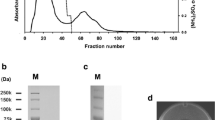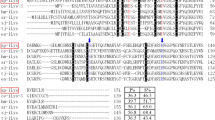Abstract
L-amino acid oxidases (LAAOs) have antibacterial activity and play important roles in innate immunity. We have previously identified a LAAO of ~52 kDa in size from the mucus layer of the flounder Platichthys stellate (psLAAO1) and have successfully produced psLAAO1 as a secreted bioactive recombinant protein by using Pichia pastoris (P. pastoris). The recombinant psLAAO1 inhibited the growth of bacteria to the same levels as native psLAAO1 present in the mucus layer. In this study, homology modeling of psLAAO1 predicted metal coordination by residues Y241, H348, and D406. We show that the Michaelis constant (Km) of psLAAO1 decreased and the catalytic constant (Kcat/Km) value increased following pre-treatment of the protein with a chelating agent. In contrast to the non-chelated protein sample, enzymatic activity of EDTA-treated psLAAO1 gradually decreased or was absent after one or two freeze-thaw cycles. The H348A psLAAO1 mutant generated by site-directed mutagenesis and recombinantly produced by P. pastoris did not display antibacterial activity. The results of the metal detection assay revealed that for the non-metal coordinating histidine mutant (H209A, control), the levels of iron, zinc, and magnesium were similar to those of wild-type psLAAO1, whereas magnesium was not detected in the H348A mutant sample. A wild-type psLAAO1 sample treated with chelating agent did not contain zinc and magnesium ions. In conclusion, metal coordination by psLAAO1 affects enzymatic activity, and H348 is involved in the coordination of magnesium, and metal coordination by psLAAO1 provides essential structural stability.
Key Points
• Homology modeling of psLAAO1 predicted metal coordination by residue H348
• The H348A psLAAO1 mutant showed no antibacterial activity or magnesium coordination
• Metal coordination by H348 affects enzyme activity and structural stability






Similar content being viewed by others
References
Bertini I, Sigel A, Sigel H (2001) Handbook on Metalloproteins. Marcel Dekker, New York City
Biasini M, Bienert S, Waterhouse A, Arnold K, Studer G, Schmidt T, Kiefer F, Gallo Cassarino T, Bertoni M, Bordoli L, Schwede T (2014) SWISS-MODEL: modelling protein tertiary and quaternary structure using evolutionary information. Nucleic Acids Res 42:W252–W258. https://doi.org/10.1093/nar/gku340
Bloess S, Beuel T, Krüger T, Sewald N, Dierks T, Fischer von Mollard G (2019) Expression, characterization, and site-specific covalent immobilization of an L-amino acid oxidase from the fungus Hebeloma cylindrosporum. Appl Microbiol Biotechnol 103:2229–2241. https://doi.org/10.1007/s00253-018-09609-7
Butzke D, Machuy N, Thiede B, Hurwitz R, Goedert S, Rudel T (2004) Hydrogen peroxide produced by Aplysia ink toxin kills tumor cells independent of apoptosis via peroxiredoxin I sensitive pathways. Cell Death Differ 11:608–617. https://doi.org/10.1038/sj.cdd.4401385
Clifford DP, Repine JE (1982) Hydrogen peroxide mediated killing of bacteria. Mol Cell Biochem 49:143–149. https://doi.org/10.1007/BF00231175
Costa TR, Carone SEI, Tucci LFF, Menaldo DL, Rosa-Garzon NG, Cabral H, Sampaio SV (2018) Kinetic investigations and stability studies of two Bothrops L-amino acid oxidases. J Venom Anim Toxins Incl Trop Dis 24:37. https://doi.org/10.1186/s40409-018-0172-9
de Melo Alves Paiva R, de Freitas FR, Antonucci GA, Paiva HH, de Lourdes Pires Bianchi M, Rodrigues KC, Lucarini R, Caetano RC, Linhari Rodrigues Pietro RC, Gomes Martins CH, de Albuquerque S, Sampaio SV (2011) Cell cycle arrest evidence, parasiticidal and bactericidal properties induced by L-amino acid oxidase from Bothrops atrox snake venom. Biochimie 93:941–947. https://doi.org/10.1016/j.biochi.2011.01.009
Deolindo P, Teixeira-Ferreira AS, DaMatta RA, Alves EW (2010) L-amino acid oxidase activity present in fractions of Bothrops jararaca venom is responsible for the induction of programmed cell death in Trypanosoma cruzi. Toxicon 56:944–955. https://doi.org/10.1016/j.toxicon.2010.06.019
El Hakim AE, Salama WH, Hamed MB, Ali AA, Ibrahim NM (2015) Heterodimeric l-amino acid oxidase enzymes from Egyptian Cerastes cerastes venom: Purification, biochemical characterization and partial amino acid sequencing. J Genet Eng Biotechnol 13:165–176. https://doi.org/10.1016/j.jgeb.2015.09.003
Feliciano PR, Rustiguel JK, Soares RO, Sampaio SV, Cristina Nonato M (2017) Crystal structure and molecular dynamics studies of L-amino acid oxidase from Bothrops atrox. Toxicon 128:50–59. https://doi.org/10.1016/j.toxicon.2017.01.017
Fujii K, Zhang H, Usuda K, Watanabe G, Nagaoka K (2015) Lactogenic hormone stimulation and epigenetic control of L-amino acid oxidase expression in lactating mammary glands. J Cell Physiol 230:2755–2762. https://doi.org/10.1002/jcp.25000
Georgieva D, Murakami M, Perband M, Arni R, Betzel C (2011) The structure of a native l-amino acid oxidase, the major component of the Vipera ammodytes ammodytes venomic, reveals dynamic active site and quaternary structure stabilization by divalent ions. Mol Biosyst 7:379–384. https://doi.org/10.1039/c0mb00101e
Hahn K, Neumeister K, Mix A, Kottke T, Gröger H, Fischer von Mollard G (2017) Recombinant expression and characterization of a L-amino acid oxidase from the fungus Rhizoctonia solani. Appl Microbiol Biotechnol 101:2853–2864. https://doi.org/10.1007/s00253-016-8054-y
Hughes AL (2010) Origin and diversification of the L-amino oxidase family in innate immune defenses of animals. Immunogenetics 62:753–759. https://doi.org/10.1007/s00251-010-0482-8
Izidoro LF, Sobrinho JC, Mendes MM, Costa TR, Grabner AN, Rodrigues VM, da Silva SL, Zanchi FB, Zuliani JP, Fernandes CF, Calderon LA, Stábeli RG, Soares AM (2014) Snake venom L-amino acid oxidases: trends in pharmacology and biochemistry. Biomed Res Int 2014:196754–196719. https://doi.org/10.1155/2014/196754
Kanazawa N, Shintani S, Ohta K, Kitajima S, Ehara T, Kobayashi H, Kizaki H, Tsuchiya T (2004) Achacin induces cell death in HeLa cells through two different mechanisms. Arch Biochem Biophys 422:103–109. https://doi.org/10.1016/j.abb.2003.12.007
Kasai K, Ishikawa T, Komata T, Fukuchi K, Chiba M, Nozaka H, Nakamura T, Sato T, Miura T (2010) Novel L-amino acid oxidase with antibacterial activity against methicillin-resistant Staphylococcus aureus isolated from epidermal mucus of the flounder Platichthys stellatus. FEBS J 277:453–465. https://doi.org/10.1111/j.1742-4658.2009.07497.x
Kasai K, Hashiguchi K, Takahashi H, Kasai A, Taeda S, Nakano M, Ishikawa T, Nakamura T, Miura T (2015a) Recombinant production and evaluation of an antibacterial L-amino acid oxidase derived from flounder Platichthys stellatus. Appl Microbiol Biotechnol 99:6693–6703. https://doi.org/10.1007/s00253-015-6428-1
Kasai K, Ishikawa T, Nakamura T, Miura T (2015b) Antibacterial properties of L-amino acid oxidase: mechanisms of action and perspectives for therapeutic applications. Appl Microbiol Biotechnol 99:7847–7857. https://doi.org/10.1007/s00253-015-6844-2
Kitani Y, Tsukamoto C, Zhang G, Nagai H, Ishida M, Ishizaki S, Shimakura K, Shiomi K, Nagashima Y (2007) Identification of an antibacterial protein as L-amino acid oxidase in the skin mucus of rockfish Sebastes schlegeli. FEBS J 274:125–136. https://doi.org/10.1111/j.1742-4658.2006.05570.x
Laemmli UK (1970) Cleavage of structural proteins during the assembly of the head of bacteriophage T4. Nature 227:680–685. https://doi.org/10.1038/227680a0
Lazo F, Vivas-Ruiz DE, Sandoval GA, Rodríguez EF, Kozlova EEG, Costal-Oliveira F, Chávez-Olórtegui C, Severino R, Yarlequé A, Sanchez EF (2017) Biochemical, biological and molecular characterization of an L-Amino acid oxidase (LAAO) purified from Bothrops pictus Peruvian snake venom. Toxicon 139:74–86. https://doi.org/10.1016/j.toxicon.2017.10.001
Li R, Li A (2014) Antibacterial efficacy of recombinant Siganus oramin L-amino acid oxidase expressed in Pichia pastoris. Fish Shellfish Immunol 41:356–361. https://doi.org/10.1016/j.fsi.2014.09.017
Li R, Dan X, Li A (2013) Siganus oramin recombinant L-amino acid oxidase is lethal to Cryptocaryon irritans. Fish Shellfish Immunol 35:1867–1873. https://doi.org/10.1016/j.fsi.2013.09.026
Macheroux P, Seth O, Bollschweiler C, Schwarz M, Kurfürst M, Au L-C, Ghisla S (2001) L-amino acid oxidase from the Malayan pit viper Calloselasma rhodostoma. Eur J Biochem 268:1679–1686
Mukherjee AK, Saviola AJ, Mackessy SP (2018) Cellular mechanism of resistance of human colorectal adenocarcinoma cells against apoptosis-induction by Russell's Viper venom l-amino acid oxidase (Rusvinoxidase). Biochimie 150:8–15. https://doi.org/10.1016/j.biochi.2018.04.017
Murakawa M, Jung S-K, Iijima K, Yonehara S (2001) Apoptosis-inducing protein, AIP, from parasite-infected fish induces apoptosis in mammalian cells by two different molecular mechanisms. Cell Death Differ 8:298–307. https://doi.org/10.1038/sj.cdd.440081
Nagaoka K, Aoki F, Hayashi M, Muroi Y, Sakurai T, Itoh K, Ikawa M, Okabe M, Imakawa K, Sakai S (2009) L-amino acid oxidase plays a crucial role in host defense in the mammary glands. FASEB J 23:2514–2520. https://doi.org/10.1096/fj.08-126466
Okubo BM, Silva ON, Migliolo L, Gomes DG, Porto WF, Batista CL, Ramos CS, Holanda HH, Dias SC, Franco OL, Moreno SE (2012) Evaluation of an antimicrobial L-amino acid oxidase and peptide derivatives from Bothropoides mattogrosensis pitviper venom. PloS One 7:e33639. https://doi.org/10.1371/journal.pone.0033639
Waterhouse A, Bertoni M, Bienert S, Studer G, Tauriello G, Gumienny R, Heer FT, de Beer TAP, Rempfer C, Bordoli L, Lepore R, Schwede T (2018) SWISS-MODEL: homology modelling of protein structures and complexes. Nucleic Acids Res 46(W1):W296–W303. https://doi.org/10.1093/nar/gky427
Wellner D, Meister A (1961) Studies on the mechanism of action of L-amino acid oxidase. J Biol Chem 236:2357–2364
Williams RJ (1995) Energised (entatic) states of groups and of secondary structures in proteins and metalloproteins. Eur J Biochem 234:363–381. https://doi.org/10.1111/j.1432-1033.1995.363_b.x
Zhang YJ, Wang JH, Lee WH, Wang Q, Liu H, Zheng YT, Zhang Y (2003) Molecular characterization of Trimeresurus stejnegeri venom L-amino acid oxidase with potential anti-HIV activity. Biochem Biophys Res Commun 309:598–604. https://doi.org/10.1016/j.bbrc.2003.08.044
Acknowledgments
We are grateful to Dr. Ishikawa and Mr. Ohishi for advice and discussion. We thank Ms. Tabata, Mr. Ishizuka, Ms. Takayama, Ms. Uraguchi, Mr. Honma, and Ms. Sakuyama for helpful assistance. We thank Edanz Group (https://en-author-services.edanzgroup.com/ac) for editing a draft of this manuscript.
Funding
This work was supported in part by a Grant for Priority Research Designated by the Japan Science and Technology Agency (Grant No. JPMJTM19AL) and a fund from SNOWDEN Co., Ltd.
Author information
Authors and Affiliations
Contributions
Study design: KK, TN, and TM. Experimental: KK, YI, and AN. Data analysis: KK. Manuscript writing and revision: KK, KA, TN, and TM.
Corresponding author
Ethics declarations
Conflict of interest
All authors have no conflicts of interest to declare.
Ethical approval
This article does not contain any studies with human participants or animals performed by any of the authors.
Additional information
Publisher’s note
Springer Nature remains neutral with regard to jurisdictional claims in published maps and institutional affiliations.
Rights and permissions
About this article
Cite this article
Kasai, K., Ito, Y., Nitta, A. et al. Metal coordination by L-amino acid oxidase derived from flounder Platichthys stellatus is structurally essential and regulates antibacterial activity. Appl Microbiol Biotechnol 104, 9645–9654 (2020). https://doi.org/10.1007/s00253-020-10914-3
Received:
Revised:
Accepted:
Published:
Issue Date:
DOI: https://doi.org/10.1007/s00253-020-10914-3




